Valencia Joaquín Sorolla railway station
I traveled recently to Valencia. On the way in, it was all business as normal: I took a train from Barcelona Sants and it stopped at the traditional Valencia Nord railway station. But the way back had something new on store for me: the train would depart from the new Joaquín Sorolla railway station.
Now, I haven't been following with much attention the new railway developments in Valencia, so this news took me by surprise. There was a new station? Where was it? Would that be far away from Nord? (because I would travel to Valencia Nord first) And finally the most poignant question of all was: Why? Why a new railway station? It isn't as if Valencia Nord has, say, all platforms in use at the same time, or traffic like Clapham Junction.
But let's go step by step in unveiling the answers to these questions.
I quickly found out that Valencia-Joaquín Sorolla was the final terminus for the new high speed railway line between Madrid and Valencia, which you might have read about in the press as the 'AVE' (Alta Velocidad Española, or Spanish High Speed). Yes, that project that marveled Barack Obama when he visited Spain a while back. These trains do not use the same tracks than the 'normal' trains do, so new tracks have had to be built along the already existing ones. Sometimes new stations too, when for technical reasons it is impossible to accommodate existing spaces to fit the new and demanding trains. That I understand, as sometimes there is simply no room in highly urbanised areas. However, this was a very strange case.
So why do I say this is strange? For starters, the train I took wasn't an AVE train. It was just a plain Euromed that used to happily depart from Nord a few years ago. Maybe they want to lure users of this train into using the AVE trains too (as Euromed is the faster train between Barcelona and Valencia). Alvia trains departing for Madrid (not AVEs) were there too.
Secondly, the location of the new station is just '700 metres' away from the old one. It has been built on the space which was previously occupied by the freight station and related buildings. These warehouses haven't been used for a very long time, as the freight and logistic activities have been relocated to other, less congested, areas of the city. Consequently the warehouses and surrounding area had fallen in a state of decay and abandonment for years, many, many years. Pretty much for twenty or more years, I'd dare to say.
In parallel to this, there were talks of a new project for the railway area. It was pompously named "Parque Central" (Central Park) and it was promised to be almost an Eden on Earth. Greenery, fresh pure air and other niceties. All in the centre of Valencia. They would dig tunnels, place the tracks in them and cover everything again, only this time we would have trees and not trains crossing the space between neighbourhoods. People from across the street would join hands and dance on the park, enjoying that newly found brotherhood. It sounded so fluffy and nice that it was hard to believe. Please allow me to reiterate: this promise has been sustained, repeated and renewed during twenty or more years, which in Spanish election terms means five consecutive governments have failed to fulfill such promise, yet people have believed in the promise once and once again.
But back to the station: it is placed right in the place where the greenery would be, were this Park project to be executed. But fear not for the future of the Park!
, I said to myself, since this new station is just temporary! Or so I found everywhere I looked. It is hard to find official information about the station; instead one has to rely on 'unofficial' sources. So assuming the new station was temporary, what would be the fate of the station (and the grounds it stands on) when they make up their mind about where should trains terminate?
I found there is a propaganda website detailing the plans for the area. In it, they finally show some renders of the project. At last! Some images and less talking! (if you can bear the "Multimedia" animation for showing images, that is)
In the first image, you can see that they would build one of those hefty square dead ugly buildings they absolutely adore to stick in the middle of already consolidated areas, so that our eyes bleed every time we look at it. Look at the volume of it, the mass, the shadow it will cast over surrounding buildings. If I lived nearby I'd rather live with the trains than with that eyesore. I bet they also plan to build a hotel for business travelers on top of the station, but that is not detailed on the website.

On the second image you can see the future layout of the area. There's a new hangar for trains between the old station and the eyesore (since presumably trains won't be allowed to go upstairs), then the eyesore, and then the mighty park, which sincerely doesn't look that impressive now. That jungle in which we could get lost and forget we were in the middle of the city? It's just 400 metres long. Ahem. Finally, there will be new homes! Of course! And I bet 90% of the old station will be focused on shopping and shopping only.

Now an image courtesy of me, showing the location of all this in the map - so you get an idea:

As the new station isn't in the map imagery, I drew it. The old one is too, as well as "Eden". Quite nice, right? But we're going too far in the future. Let's go back to the present and analyse the current 'new' station.
I arrived in a Cercanías train, as I've done many times already. It's pretty much what is known as a commuter type of train elsewhere, and spots the usual mixture of workers and leisure people. On arrival, we stopped on platform 6 sector C, which is actually outside the main hangar. Some years ago this line (Xàtiva) used to stop in platform 4, inside. That was nice, as you could revel in approaching the big city, and slowly entering it through the big arched roof was somehow magnificent, as your eyes got used to the shady inside and its rich Valencian Modernist decorations. Now they have expanded the area in front of the platforms and it seems the trains don't fit any more inside the building. This is probably an advance of what's to come.
So since they built the station so far away from the station which most people use, they had to provide a shuttle bus between stations. I had plenty of time so I decided to walk and explore from Nord to Joaquín Sorolla. There are many signals pointing passengers towards the shuttle bus, so it's hard to miss it (unless you deliberately want to avoid it, like me). There were signals for walking directions too, just in case you missed the shuttle too! It was quite hot for British standards, but it could be withstood.
Once you get out the station using one of the doors on your left, pass the taxi stop and turn left for the Bailén street. Then keep on walking and marvel at the many peculiar shops and buildings. There's a lot of sex-shops in that area, as well as Chinese businesses: restaurants, clothes shops, and even driving instructors. I am not sure whether these two worlds are related, to be honest. The architecture in most of the buildings has something to look at, specially the balconies with their particular iron ornaments.
So you're walking and you reach what it seems like the end of the street. No, you're wrong (I was wrong too). That's just a pass over a tunnel that joins two extremely noisy avenues (and which will be above ground in the aforementioned project, if I understood correctly). So you keep walking by turning slightly right and then left again, and then take the Bailén street again.
In this time the panorama has changed considerably. There's hardly any shadow in sight. I'm happy that I decided to avoid carrying more books or I would be repenting at that very time. I also stopped to take a couple of pictures:
This is taken looking towards the old station. The hangar can be seen behind a tree, more or less in the middle of the picture:
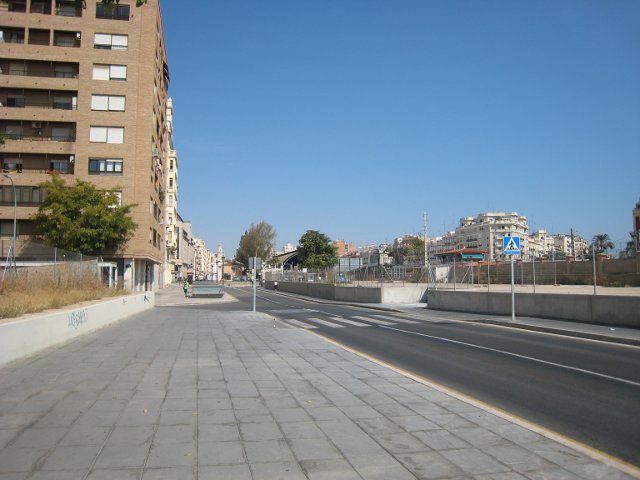
The next picture is taken looking towards the new station. This empty space was previously used by the freight station, as mentioned.
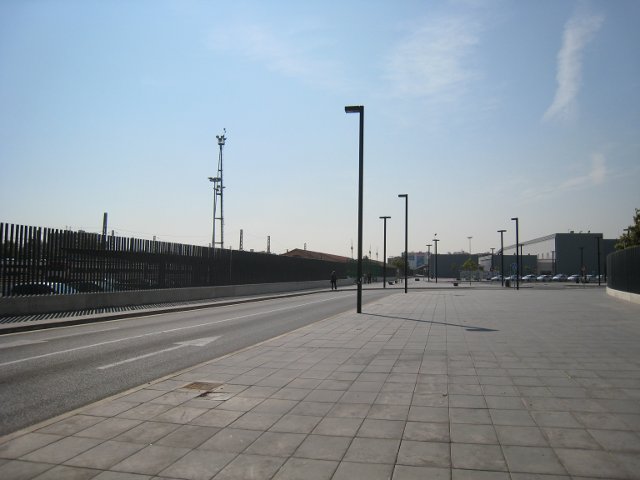
There used to be a ornate fence around the freight station, but it has been mostly replaced with a new 'functional' fence consisting of bare metal sticks. Fortunately they have had the decency to keep and renovate part of the old fence so you can see how it looked like:
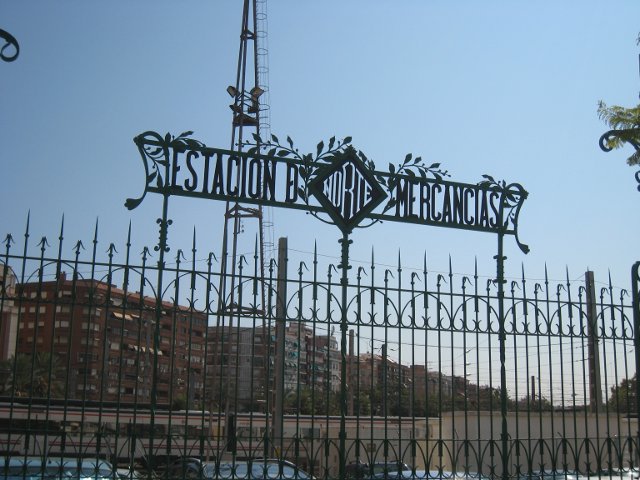
Here's a detail so you can see how elaborate the iron work is:
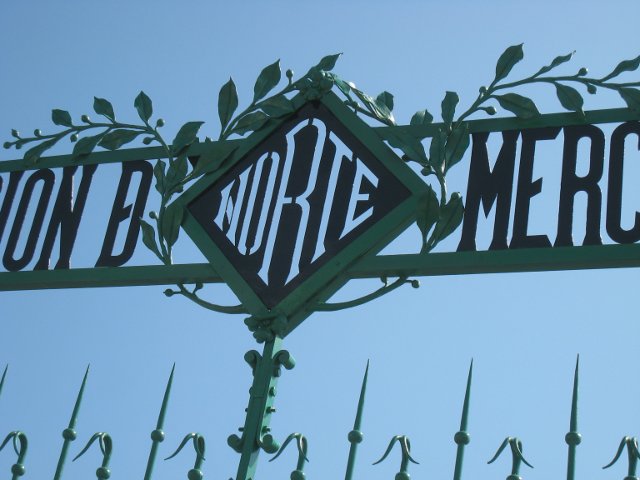
I've always found these sort of ornaments deliciously lovely. They seem to be a mostly Valencian resource as I've hardly seen them in use outside this area.
So we wave goodbye to the old fence sign and walk the last metres before the station. There are two bus stops on the left of our way. One is for the shuttle bus, the other for regular buses, although I don't recall having seen any.
The building definitely has a minimalistic sense of temporality built in. It seems like something that was quickly hoarded together in order to inaugurate the station on time and might blew if enough wind blows. Still they spent some money on a big clock (sponsored by Festina, of course):

This is what you see when you get out of the station:

It's definitely not the sort of welcome you get when arriving to Nord.
The main entrance:
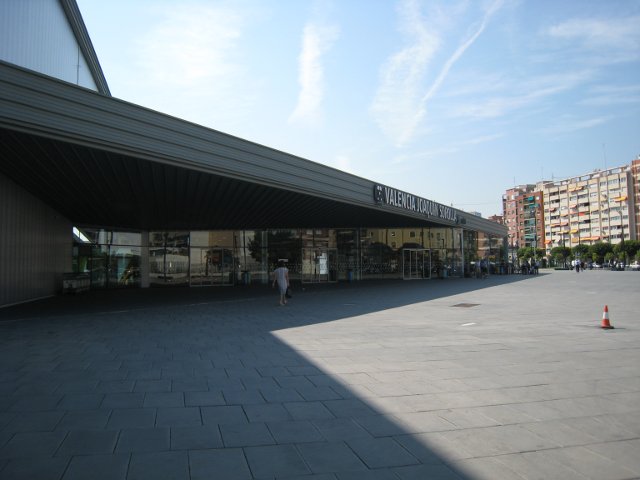
The inside is airy, though maybe a tad too much. It isn't closed so I would expect some deadly cold air draughts when waiting for a delayed train on winter. Well, at least it's got a roof.
There are also many screens, running advertisements and propaganda for the AVE, for Valencia and for some car whose brand I can't remember right now. All these advertisements had sound, which made them really annoying after a while: you can try to avoid looking at the screens, but you won't be able to avoid listening to them.
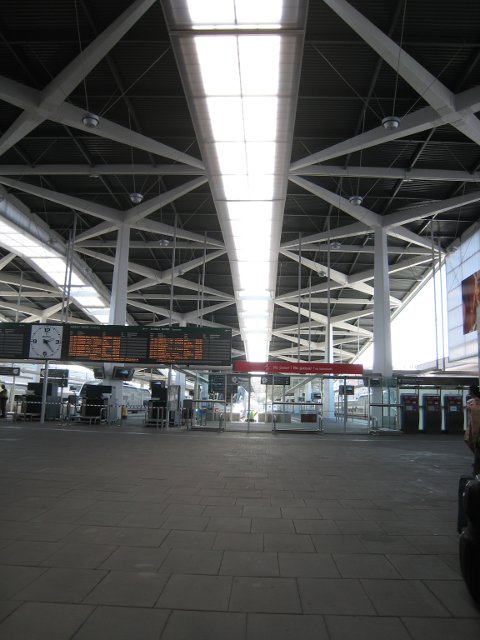
There was also an 'information' corner with another display showing the other new AVE stations. This was accompanied by interviews with the architects and engineers that have worked on the projects, all of which said it had been an excellent work and it was a great thing for Spain; there were also interviews with 'plain' people, all of whom loved the project and said it was great for their respective municipalities, and interspersed with this all were pieces of institutional brain washing and propaganda which cheekly declared these works as the best thing ever to happen to Spain, with sentences such as
- we've got the tallest bridge!!
- and the longest tunnels!
- and the lengthiest train lines!
- and so Spain is better than anyone else!
Only many of the sentences had grammatical errors!
I was getting increasingly nervous by experiencing all this, so I just finished my (home made) sandwich and had a walk around the otherwise quiet station.
The usual franchises are present: fnac, claire's, Accessorize, natura... I see there's a strongest presence of franchises that appeal to foreign visitors, and the newspapers stand was prominently showing foreign press on its door. Surprisingly though, the only announcements in English are for the AVE trains to Madrid, while the other trains are just announced in Spanish and pseudo-Valencian.
I found a nice and original shop though: it was dedicated to horchata-based products. Horchata is the traditional summer beverage in Valencia, and it was about time someone promoted it as it deserves! As you can see I'm a big fan of horchata, or Orxata as we call it in Valencia. The shop is called "Mon Orxata", and I didn't take any picture since I was so happy with the discovery that I immediately ran to examine the menu and choose something exotic and orxata-based for dessert. There is much to choose from, from traditional liquid or iced Orxata to some sort of smoothies and mixes with Orxata as its base, and if that's not your thing, you can always have some coffee.
The other thing that impressed me was the amount of other products on display. From chocolate made with tigernuts (the essential Orxata ingredient) to soap-bars, candies, oil... there were some creative uses of Orxata and tigernuts there, so if you want to make an original present you now know where to look. They've got a website too, though I'm not sure if they serve overseas :-)
So I got a 'Torronera' cocktail, which was a shake of torró and orxata. Torró (or turrón in Spanish) is an almond based sweet, mostly elaborated in Alicante and which is generally eaten on Christmas in the rest of Spain since it's incredibly caloric. However, it is still consumed in a somehow more liquid way in ice creams during the summer in Valencia, or as part of other recipes. There can never be enough torró. As a funny side note, Torró is also a popular Valencian surname.
I picked my drink and went outside, as there was no seating inside. The tables outside weren't under any roof, so it's going to be interesting if it rains or the sun is shining over the tables. Valencia is not strange to 35+ degrees, just in case you wonder.
There were mostly railway workers in the tables, having coffee in their breaks. Some North American tourists, following the traditional 'noisy American tourist' cliche. Little else. I went inside again after finishing my drink, with the hope to find a toilette.
Which I did. Of course I vainly expected it to have space for bringing your suitcase inside the cubicle. Had I brought a bigger suitcase I would have had to leave it outside while I did 'my thing', exposing it to thieves and etc. Of course there wasn't paper and of course it wasn't too clean. But that's as usual, I guess. At least it had soap and the hand-drier worked!
On the way inside I bought some chewing gum and browsed the 'fnac express' shop. It was a little letdown, since they pretty much focused on best-sellers and it was certainly depressing. Several books by the same 'award-winning' author monopolised an entire shelf. On another shelf were the recently published books by the two presidential candidates, which casually had decided to publish their pamphlets months away from the election. Casually! Then, the usual Terry Pratchet, Ken Follet and etc shelves. Really boring. I didn't even attempt to look at the press section, as we are still in September and they tend to inundate the market with collectables on stupid things and hobbies appealing to the adults' sense of back-to-school commitment. Which is slightly depressing too. I was sorely missing the station book stores of old, with their eccentric and mildly outdated selection, and proper 'paper smell' when entering the shop.
The train platform hadn't been announced yet. There was a 40 minutes-delayed Euromed for Alicante. I hoped that would not be my case as the inanity of the place was beginning to get on my nerves. Finally, the platform was announced exactly 30 minutes before the departure time. I went through the security scanner, and took the opportunity to take a picture of waiting AVE trains:
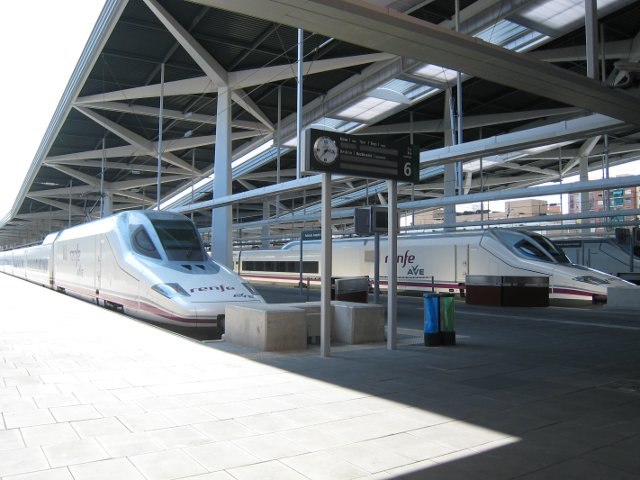
It was something you had to do quickly and discreetly since the over-jealous security people were already warning people to stop taking pictures. And I had heard about not very pleasant experiences with security guards in train stations, so I decided to err on the side of caution.
We still had to wait a couple of minutes until the 'reception' was assembled. Everything is so temporary that they have to set up the computer in the check-in counter minutes before it is due. Thankfully they only need to hook up the laptop to the laser barcode reader, but still it feels excessively transient, so to say. The check-in process is straightforward: you hand over your ticket, its barcode is read, and you're told which car to seat in. Which is redundant, because you already know it, as it is printed in the ticket. But I guess it's a courtesy thing.
Then you just walk towards the train and from time to time say 'hi' to the nice staff on the doors waiting to help old people bring their luggage on board, find your seat and store your luggage somewhere.
Finally, the station sign from inside the train:
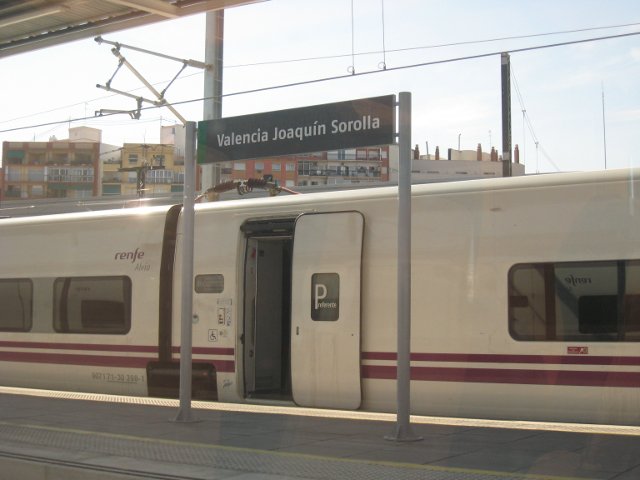
On the train quality of service: I am mildly disappointed too. From what I've read, part of the rolling stock that used to serve the Euromed line has been refurbished in order to serve the AVE lines (!!!). The train I boarded wasn't a proper Euromed, but more like a normal Talgo instead. Seats were quite worn out and were not excessively comfortable, plus they transmitted every single of your movements to your seat neighbour (and the opposite was true as well). There was more than enough leg room (though I'm not a tall person), but the fact that if the neighbour moved in her seat it was enough to move my seat was quite annoying.
I ended up going to the coffee car as I always like to do. The views between Tarragona and Barcelona, when the train goes over the Garraf coasts, are just breathtaking--like looking through a window to the sea. It's just great; if you take this train be sure to look through the window. Having a coffee while watching this show is just an out of the ordinary experience.
So all in all, and coming back to the new station: I don't like it. I don't think it's enough for Valencia. It's not classy at all, unlike the Nord station we all know and love. Valencia has a long heritage and deserves more than a quickly assembled together hack for station. A passenger arriving in Valencia deserves to get a proper welcome too, one that is classy and tasteful, and immediately surrounds you in a uniquely Valencian style.
No, you can't replace this façade or these interiors with cheap glass panels or a cubic eyesore and be done with it.
Some links:
- Many pictures of the Nord station
- Joaquín Sorolla Station profile
- Newspaper article on the new station
